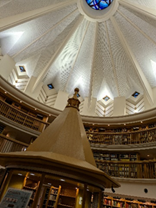Is a 10,000 yen tourist tax high or low?≪9≫ ~How to use the tourist tax(Accommodation tax), the creation of the Okoshiyasu Program, and new tourism proposals The creation of a tourist library (library cafe) (Welcome Program) ~
 |
 |
Photo taken on November 2, 2024 at the International Research Center for Japanese Studies
Yoshie Doi
Establishment of a tourist library
Libraries are the most commonly used public facilities, but they are intended for local residents and do not seem to be used by tourists. In a survey for Japan Travel Bureau Corporation’s Tourism Culture No. 243 (October 2019), there was a survey on whether libraries are expected to be used by people outside the local area.
Unfortunately, the majority of municipalities responded that they had not anticipated this, with only 14.8% of the 81 municipalities anticipating tourist use. 64.2% of municipalities did not anticipate this, and 72.8% had no cooperation between the tourism department and the library. We hope that Kyoto Prefecture and Kyoto City will take the lead in establishing this tourist library.
In Kyoto, there are the Kyoto Prefectural Kyoto Gaku and Rekisaikan Museum and the Kyoto City Historical Museum, and there are libraries in each ward. Any Kyoto resident can use and borrow books. Tourists can browse them once, but how about creating a tourist library that tourists can use frankly?
I would like to propose the creation of a tourist library (library cafe) that can accommodate the intellectual pursuits of regular visitors to Kyoto. Although it is a slightly old survey, in July 2019, a “Survey on Tourism and Libraries” (81 organizations responded) was conducted on municipal libraries, and 14.8% of the respondents said they “anticipate tourists’ use,” while 64.2% said they “do not anticipate” it.
In addition, 72.8% of respondents said that there is currently no collaboration between the tourism department and the library, and 67.9% said that there are no plans for collaboration in the future. (Japan Travel Bureau, Tourism Culture, No. 243, October 2019)
(Continued in the next issue)
The end of document
Translated by Masami Otani
